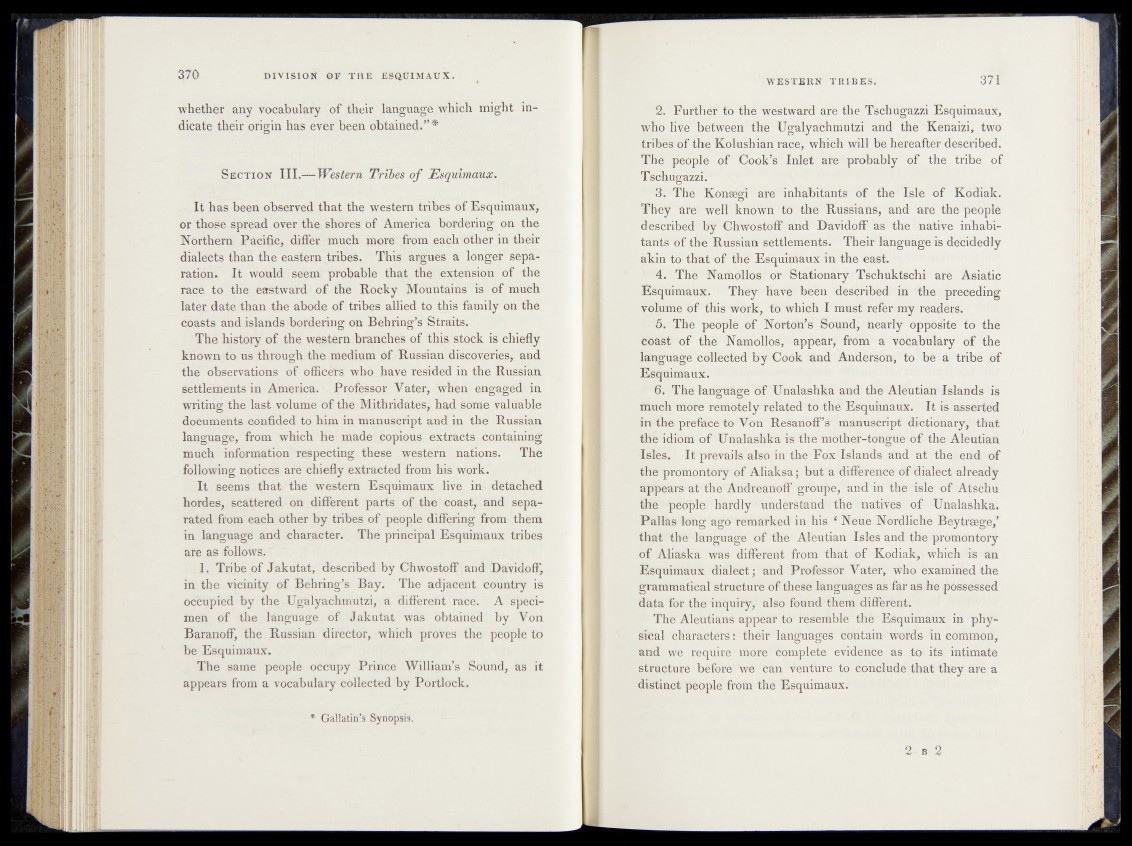
whether any vocabulary of their language which might in
dicate their origin has ever been obtained.” *
S ection I I I .— Western Tribes o f Esquimaux.
It has been observed that the western tribes of Esquimaux,
or those spread over the shores of America bordering on the
Northern Pacific, differ much more from each other in their
dialects than the eastern tribes. This argues a longer separation.
It would seem probable that the extension of -|pb
race to the eastward of the Rocky Mountains is of much
laterjiate than the abode of tribes allied to this family bn the
coasts and islands bordering on Behring’s Straits.
The history of the western branches of this stock is chiefly
known to us through the medium bf Russian discoveries,, and
the observations of officers, who have resided in the Russian
settlements in America. Professor Vater, when engaged in
writing the last volume of the Mithridates, had some valuable
documents confided to him in manuscript anrd in the Russian
language, from which he made copious extracts containing
much information respecting these western nations. The
following notices are chiefly extracted from his work.
It seems that the western Esquimaux live in detached
hordes, scattered on different parts of the coast, and separated
from each other by tribes of people differing from them
in language and character. The principal Esquimaux tribes
are as follows. 7
1. Tribe of Jakutat, described by Chwostoff and Davidoff,
in the vicinity of Behring’s Bay. The adjacent country is
occupied by the Ugalyaehmutzi, a different race. A specimen
of the language of Jakutat was obtained by Ton
BaranofF, the Russian director, which proves the people to
be Esquimaux.
The same people occupy Prince William’s Sound, as it
appears from a vocabulary collected by Portlock.
Gallatin’s Synopsis.
2. Further to the westward are the Tschugazzi Esquimaux,
who livb^feêtween the ugal|achmutzi and the Kenaizi, two
tribes of the Kolushian race, which will be hereafter described.
The people of Cook’s Inlet ate probably of the tribe of
Tschugazzi.'■ "
***$? The KöHÄl ate inhabitants of o the Isle of Kodiak.
They are well known to the Russians, and are the people
described by Chwostoff and Davidoff as the native inhabitants
of the Russian settlements. Their language is decidedly
akin to*'that of the Esquimaux in the east.
' 4. The NamollOs ot Stationary Tschuktschi are Asiatic
Esquimaux. They have been described i n ‘the preceding
volume of this work, to which l mnsfrefën my readers.
5. The people of Norton’s Sound, nearly opposite to the
Coast of the Nainollóë, appear, from a vocabulary of the
languttgë collected by Cook and Anderson^t'O be a tribe of
Esquimaux.
6. The language of Unalashka and the Aleutian Islands is
much more remotely teikted to the1 Esquimaux. It is asserted
in the preface to Von Resanoflf’s manuscript dictionary, that
thé idiom of Unalashka the mother-tongue of the Aleutian
»iilis. It prevails also,in the Fox Islands' and at the; end of
the promontory of Aliaksa ; but a difference of dialCct al ready
appears at the Andreanoflf groupe;- and in thè- isle of Atsehu
the people hardly understand the natives Of' ’Unalashka.
Pallas long ago remarked in his t Neue Nördliche Beytræge,’
that the language of the Aleutian Isles and the promontory
of Aliaska was different from that of Kodiak, which is an
Esquimaux dialect; and Professor Vater, who examined the
grammatical structure of these languages as far as he possessed
data for the inquiry,' also found them different;!î
The Aleutians appear to resemble thé Esquimaux in physical
characters : their languages contain words iii common,
and we require • more complete evidence äs to its intimate
structure before we can venture to éfenchidé that they are a
distinct people from the Esquimaux.
2 - b 2